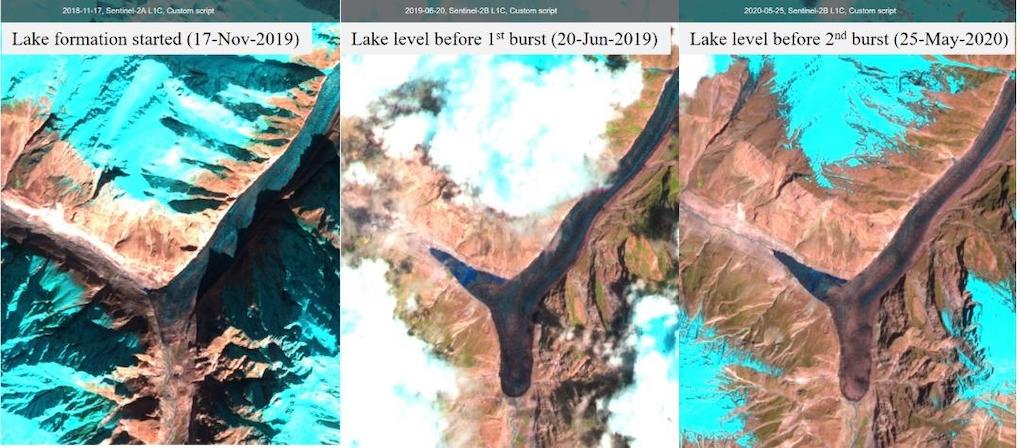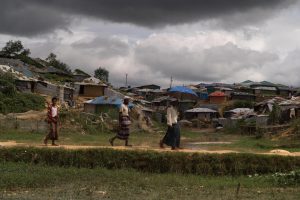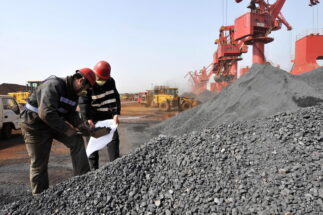“A loud rumble echoed and water started trickling down with soil and rocks. Villagers immediately left their homes and fled to safety,” recounted Manzoor Hussain. Hussain lives in Hassanabad, a village in the Hunza valley high in the Hindu Kush Himalayas in northern Pakistan.
It was siesta time on May 30 when the rumbling started. “It was not the first time, so people in the village knew what was happening. They were aware of glacial lake outburst floods [GLOFs]. They thought it was a GLOF at the Shishper glacier,” said Hussain.
In fact, a lake near the Machuhar glacier had burst its banks, causing a flood that submerged farms, the local power plant and part of the Karakoram Highway. Most residents had to sleep in tents afterwards.

Zaheer Uddin Babar, the focal person for GLOFs in the Gilgit Baltistan Disaster Management Authority, said, “We can’t interlink the recent incident with a GLOF. Satellite images received from SUPARCO [Pakistan’s Space & Upper Atmosphere Research Commission] are not indicating any glacial lake. It may be the water spilled out from a lake on the surface of the Machuhar glacier. The water flow was as low as 3,000 cusecs [cubic feet per second] only.” In some parts of the Hindu Kush Himalayas, water flow after a GLOF has been recorded at around 100,000 cusecs.
The villagers thought the May 30 incident was a GLOF because they had experienced one with a water flow of 7,000 cusecs in 2019, when a 1.5 kilometre-wide lake burst its banks. That time, a large section of the Karakoram Highway, a bridge, two power plants, some offices, over 100 houses, the water supply pumphouse and most farms were submerged.
Read: The glacier ‘marriages’ in Pakistan’s high Himalayas
Shishper is a surging, or advancing, glacier. It formed around the beginning of the twentieth century, when what was then the Hassanabad glacier in the north of the Hunza valley split into two. Machuhar is the other glacier formed by this split. Like the overwhelming majority of glaciers in the Hindu Kush Himalayas, Machuhar is receding due to the warming caused by climate change. There are over 15,000 glaciers in this tallest and youngest mountain range of the world, which stretches from Afghanistan to Myanmar. The number keeps changing as receding glaciers split into two or more.
The surge of one glacier while its neighbour melts is creating a strange situation. Babar said Shishper has been surging quickly; it moved forward two kilometres in 2018-19, though there has been no indication of a surge since November 2019. But the earlier surge blocked the drainage route of the Machuhar glacier. As a result, a lake has formed at the snout, or mouth, of the Machuhar glacier, and is getting bigger as climate change gathers pace and the rate of melt increases.
Blocking the water flowing down from the Machuhar glacier also means blocking this water supply to the Hunza River, a tributary of the transboundary Indus River.

Muhammad Riaz, director-general of Pakistan Meteorological Department, told The Third Pole, “There are more than 3,000 glacial lakes in the Karakoram ranges and 34-36 of them have been declared to be of high GLOF potential.”
The danger of a surging glacier
“But the glacier surge is a larger menace than GLOF,” said Sher Mohammad, a glacier specialist at the regional International Centre for Integrated Mountain Development, with its headquarters in Kathmandu. “There are more than 200 glaciers identified in the Karakoram range with surging or surge-like history and these glaciers cover more than 40% (7,700 square kilometres) of the total glacier area in the Karakoram.”
“The exact reason for some glaciers surging in the Karakoram is still unclear,” he added. “It has no linear correlation with snowfall anomalies and thermal changes. However, extreme weather and climate change probably affect surges and surge dynamics, such as intensification, enhance melting, creating crevasses on glacier surfaces and changing the glacier volume.”
Asif Khan, an expert on climate change and an author of the Intergovernmental Panel on Climate Change’s sixth assessment report, said, “Surging is a short-lived event, when a glacier moves 10 to 100 times faster than its normal velocity.”
Mohammad said the flooding on May 30 was probably triggered by a rise in temperature, causing significant glacier melt and increasing the size of the lake. Meteorological data shows a significant temperature rise in the Hunza area in late May. In the first half of June, water was still flowing down the hillside and being blocked by debris, posing a potential risk of another flood.
![There was a significant temperature rise in the Hunza area in late May, which probably triggered the flooding [image by: Manzoor Hussain]](https://dialogue.earth/content/uploads/2020/06/Shishper-glacier-Hunza-valley-Hindu-Kush-Himalayas.jpg)
Ali pointed out that this could lead to significant changes in future water availability in Pakistan, which is dependent almost totally on the Indus basin for irrigation and other uses. Pakistan’s agriculture sector contributes around 22% of Pakistan’s GDP, and over 45% of the country’s workforce is engaged in agriculture, directly or indirectly.
A higher glacier melting rate can also trigger GLOFs and floods downstream, leading to more infrastructure and economic losses, Ali added.
![<p>The Shishper glacier moved forward 2 km in 2018-19. [Image by: Ijlal Hussain]</p>](https://dialogue.earth/content/uploads/2020/06/Shishper-glacier.jpeg)





![There could be more muddy rain in the future, scientists say, as climate change makes wind patterns more erratic and unpredictable [Kathmandu image by: Alamy]](https://dialogue.earth/content/uploads/2020/06/Kathmandu-300x200.jpg)


